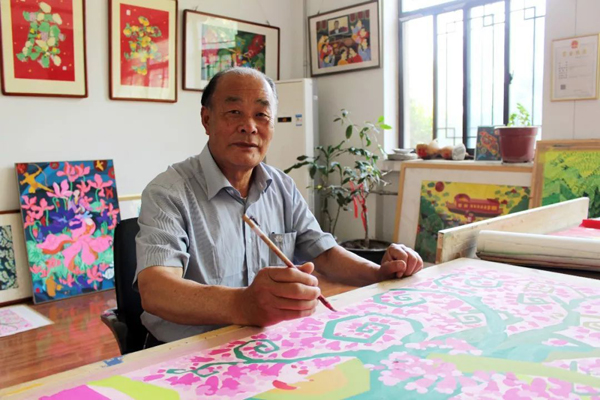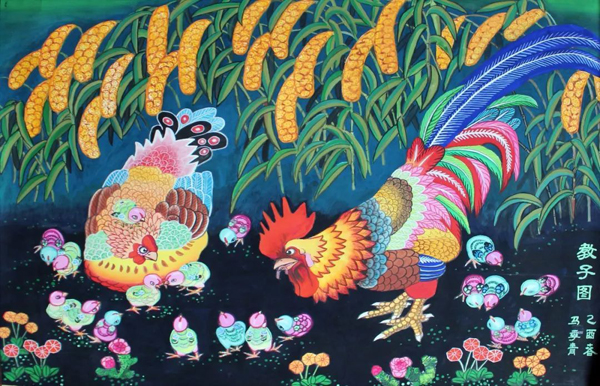
From the People's Daily App.
This is Story in the Story.
In China, frescoes were often painted on the exterior walls of farmers' houses and stone bridges to inform people about the latest government policies or to express dreams for a better life.
Today, in Qingzhou, Shandong Province, the farmer-painting industry generates over $7 million annually for the city, according to the Qingzhou Farmer Painting Institute.
Frescoes from the 1960s and '70s can often be found in Qingzhou and other renowned farmer-painting villages, such as Huxian County in Shaanxi Province and Jinshan District in Shanghai.
Farmer paintings originate from the ancient arts of wall painting, paper-cutting and embroidery, but the style of the genre emerged in the second half of the 20th century.
Typical farmer paintings are hand-painted with gouache watercolors on paper.
Their vibrant colors, thick lines and exaggerated figurative patterns enable Chinese farmers to depict rural life and express their views.
Today’s Story in the Story looks at how farmers in rural China are boosting local economies with their artistic painting skills that have long been a feature of the rural countryside.

Farmer-turned-painter Ma Jiqing has painted works portraying the development of the country's rural areas by depicting scenes of rural life for 50 years. (Photo: China Daily)
Ma Jiqing is the kind of man who looks for a coin on the ground while not losing sight of the moon. Though farming and painting may not seem connected-with one being down-to-earth and the other a refined pursuit-the 72-year-old has been doing both for the past 50 years.
The farmer-turned-painter has created works portraying the development of the country's rural areas by depicting scenes of rural life, bountiful harvests, and satisfied families.
Ma, who lives in the county-level city of Qingzhou, Shandong province, had his own way to celebrate a recent farmers' harvest festival-painting several new pieces.
One of his works shows stacks of corn dwarfed by nearby hills.
"These paintings are a salute to farmers and the festival," said Ma.
Ma is also contracted by a farmer-painting institute in Qingzhou. Paintings of different sizes hang on the walls in his workroom.
"This one earned a national award," said Ma, pointing to a painting that covers half of a wall.
"Unlike many farmer paintings featuring red and yellow, this has different shades of blue. It depicts the repeal of agricultural taxes and farmers celebrating the event," said Ma.
Ma has enjoyed painting since he was little. As his family was sick when he was a child, the cornfield was his workroom, and borrowed comic books were his teachers.
In the 1980s, farmer painting was not popular, as the country's rapid economic growth created other competing genres. However, in the 1990s, it regained some momentum as cultural development began to gain momentum.

A painting by Ma Jiqing features a family of chickens. (Photo: China Daily)
Now, in Qingzhou alone, more than 30,000 people are engaged in farmer painting. Many run online stores selling paintings and cultural products.
"When my parents were farming, I liked to draw them on the back of my notebook. And I traced patterns from comic books to learn skills," he said
In his 20s, Ma worked and dried tobacco leaves in a local production team, formerly the basic farming unit in the commune system of China. But when he learned that the local government was seeking people to paint farming-themed frescoes, he signed up right away.
To make time for painting, Ma asked his colleague to switch shifts with him. In the following two weeks, he painted during the day and worked at night, with barely any time to sleep.
"I did not realize they were farmer paintings. I just enjoyed painting rural life," said Ma.
Wan'an County in Jiangxi Province is home to dozens of farmer painters. In 2013, local authorities invested more than 70 million yuan, so art teachers could go to villages and train local residents.
In 2017, the county’s booming farmer painting sector attracted 500,000 tourists, helping local families that provide homestay services to earn money. Xiao Qun, a local farmer painter whose paintings feature local landscapes and capture the scenes of harvesting, made 100,000 yuan by selling paintings in 2017.
Chinese grassroots art is also recognized internationally. From 2015 to 2018, the institute organized three exhibitions in France, the US, and South Korea.
"I prefer to be called 'farmer' instead of 'artist,' and the farmland will always be my spiritual home. Canvases are my fields, and I want to come up with drawings to better reflect the aspirations of farmers," Ma said.
(Produced by Nancy Yan Xu, Lance Crayon, Brian Lowe, and Paris Yelu Xu. Music by: bensound.com. Text from Global Times and China Daily.)


